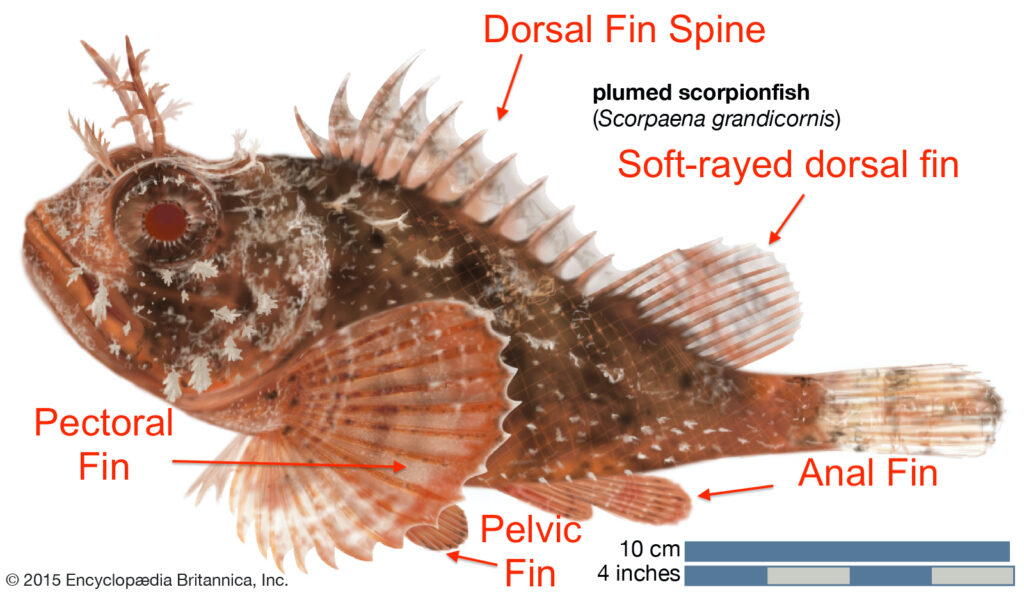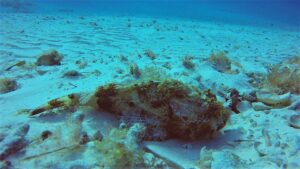Last week we had an article called Take a Closer Look that introduced you to the Scorpionfish. If you missed that article, that’s ok, simply CLICK HERE to be taken to that page. This week, for your reading enjoyment, we have a part two of that article.
Scorpionfish Defense
The spines and venom are defensive and not for catching prey. When threatened or touched, the scorpionfish will erect its spines. The scorpionfish can deliver venom through its dorsal, anal and pelvic fin spines. The venom is delivered, through bi-lateral grooves in their spines, from pressurized venom glands. The venom is automatically injected upon penetration of the spine. Envenomation can be potentially fatal for other animals. It is rarely fatal for humans but is said to cause immediate excruciating pain that can last for hours. In addition, it can cause intense throbbing, redness, bruising, numbness and swelling. Severe reactions can result in nausea, vomiting, abdominal cramps, tremors, decreased blood pressure, shortness of breath and abnormal heart rhythms.
The severity of the envenomation depends on the size of the fish, the number of spines penetrating the skin and the size and overall health of the envenomated person. Anaphylactic shock is possible if one is allergic to the venom. The scorpionfish venom retains full potency for up to 48 hours after the animal’s death. Human envenomation is usually accidental and the result of a swimmer stepping on the fish or the fish being handled by a fisherman or aquarist. It can also occur when accidentally or intentionally touched by a scuba diver, which can easily be prevented by using good diving practices to avoid contact. The PADI Peak Performance Buoyancy course or the SDI Advanced Buoyancy Control course can certainly help in that regard. More information can be found at https://www.padi.com/courses/peak-performance-buoyancy or https://www.tdisdi.com/sdi/get-certified/advanced-buoyancy/. If you are interested in the Peak Performance Buoyancy course for next trip please inquire at the Scuba Shack shop desk or let us know when you make your reservation.
Treating Scorpionfish Injury
Treating a scorpionfish injury involves thoroughly washing the area with soap and water and removing any foreign material. Control bleeding, as necessary. Immersing the affected area in non-scalding hot water, up to 113˚F (45˚ C) for 30 to 90 minutes can help with pain. Apply antibiotic ointment and bandage, as necessary. If needed, pain control medications can be used to further help with the pain. After first aid, you should seek a professional medical evaluation to make sure there is no foreign material left in the wound. It is also likely that you will need a tetanus vaccination. More detailed information about treating this and other marine like injuries can be obtained by taking DAN’s Hazardous Marine Life Injuries course https://www.diversalertnetwork.org/training/courses/HML.
Scorpionfish meat is marketed for human consumption. Its non-fishy tasting meat is considered a delicacy in China, Japan and other parts of the world. An upscale New York City restaurant uses scorpionfish for its fish and chips, which it serves exclusively on its lunch menu. It is described as a cross between monkfish and sea bass. The restaurant says it can be difficult to source and sells at market for $16-$17 per pound.
The scorpionfish is a dominant predator with few natural predators. The schoolmaster, mutton snapper, sharks, rays, moray eels and occasionally sea lions have been known to make a meal out of scorpionfish. Scorpionfish are highly desirable for home aquariums due to their unique look. Since they are impossible to breed in captivity, all scorpionfish for aquariums must come from the wild. Unfortunately, humans catching scorpionfish to keep in fish tanks are the greatest threat to the scorpionfish, along with habitat loss, from the destruction of coral reefs.
On your next dive, enjoy all that the reef has to offer and when you see a piece of coral that does not look quite right………. Take a closer look.




